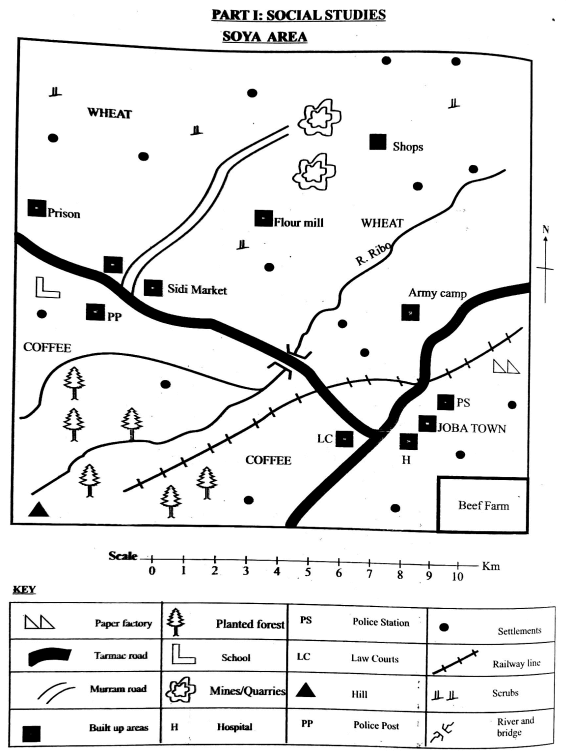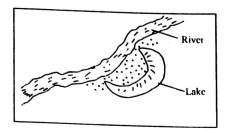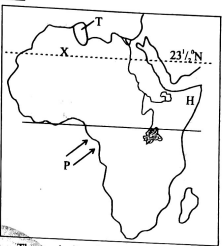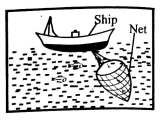
Study the map of Soya Area and answer questions 1-7
- Which one of the following products is transported along the railway line to the factory near Joba town?
- Cattle
- Tree logs
- Minerals
- Milk
- The general rise of land in Soya area is from
- North East
- North
- South West
- South
- The approximate area of the beef ranch in Soya area in square kilometres is
- 5.6km2
- 8.0km2
- 3.5km2
- 7.5km2
- A shop has been broken into in Joba town. The matter should be reported at the
- army camp
- law courts
- prison
- police station
- The type of pollution likely to be experienced most by the people living near the mines is
- noise pollution
- water pollution
- air pollution
- soil pollution
- The location of the flour mill was mainly influenced by
- availability of space
- nearness to a road
- availability of labour
- nearness to wheat farms
- The economic benefit of the forest in Soya area is that it
- influences climate in the area
- protects water catchment areas
- provides raw materials for paper making
- is a tourists attraction site
- The main function of the council of elders in the traditional Ameru government was to
- write down the laws of the community
- organize the marriage ceremonies
- solve disputes among the people
- treat diseases among the people
- Below are statements about a relief region in Africa.
- It has low altitude
- It is widespread in West Africa
- Some places are dry
The relief feature described above is- Coastal lowlands
- Rift valley region
- Plateau region
- Highland region
- Three of the following statements about horticultural farming in Netherlands are correct. Which one is not?
- Crops are sold through co-operatives
- All crops are grown in large plantations
- Some of the crops are exported
- Intensive farming is carried out
- The interaction of the Agikuyu and Akamba people in the pre-colonial period resulted in
- establishment of a new language
- exchange of trade goods
- establishment of towns in the interior
- increase in hostilities between the two communities
- Which of the following minerals is correctly matched with its end product?
- Copper - paper
- Petroleum - currency coins
- Soda Ash - lubricants
- Limestone - cement
- The diagram below represents the formation of a lake.
The lake shown above was formed through- deposition
- erosion
- faulting
- lava damming
- Three of the following statements about Homo Erectus are true. Which one is not?
- He walked upright
- He used fire
- He made iron tools
- He used speech to communicate
- The Maasai people settled on the floor of the Rift valley during the migration period because
- the areas were good for grazing
- the areas received high rainfall
- the areas had flat land
- the areas were free from tsetse flies
- The French used assimilation policy in administering Senegal in order to
- reduce resistance to colonial rule
- reduce the cost of ruling the colony
- enable Africans form political parties
- promote French way of life
- Which of the following pre-historic sites is found in Sudan?
- Magosi
- Merowe
- Ntusi
- Lalibela
- When a person who has grown up children and had written a will dies, the estate is
- taken over by a court of law
- administered by a trustee
- shared according to what is stated in the will
- given to the eldest son
- Below are characteristics of a climatic region in Africa;
- There is high humidity
- There is no distinct dry period
- Annual rainfall exceeds 2000mm
The climatic region described above is- Equatorial climate
- Mountain climate
- Mediterranean climate
- Savannah climate
- Before the coming of Europeans, the Nyamwezi people were ruled by
- kings
- hereditary chiefs
- council of elders
- warriors
- Which one of the following dams in Kenya is not found along River Tana
- Kiambere
- Kamburu
- Gitaru
- Turkwel
- The following are factors that influence population growth
- Gentle relief
- High rainfall
- Cool conditions
- Fertile soils
- Presence of towns
Which combination of factors has mostly attracted large population in Central Kenya?- (i), (iv), (v)
- (iii), (iv), (v)
- (ii), (iii), (iv)
- (i), (ii), (iii)
- Africans in Tanganyika were appointed as chiefs by the Germans mainly to
- make laws
- teach Africans traditional culture
- collect taxes
- build schools
- Which one of the following is a basic need in a family?
- Land
- Education
- Clothes
- Love
- Which of the following groups is made crops that were grown in Kenya in the pre-colonial period?
- Yams, millet, sorghum
- Maize, sweet potatoes, rice
- Kales, Irish potatoes, sorghum
- Rice, tomatoes, potatoes
- Attainment of independence in Zimbabwe was through armed struggle mainly because
- Africans had trained soldiers
- White settlers did not want to negotiate
- Africans had formed political parties
- Africans were helped by the African Unionup
- The source of river White Nile is
- Lake Chad
- Lake Tana
- Lake Albert
- Lake Victoria
- Most people in Germany live in urban centres mainly because
- they are old
- they work in towns
- they are educated
- they have small families
- Which one of the following weather instruments is used to measure the speed of wind?
- Hygrometer
- Thermometer
- Barometer
- Anemometer
Use the map of Africa below to answer questions 30 to 33
- The sun is directly overhead the line of latitude marked X in the month of
- December
- June
- September
- March
- The effect of the winds marked P is that they
- cause convectional rainfall in the Congo basin
- cause fog and mist
- lower temperatures along the coast
- cause dry conditions along the coast
- Which one of the following communities is found in the area marked H?
- Amharans
- Shilluk
- Somali
- Agiriama
- The country marked T was colonized by
- France
- Italy
- Spain
- Britain
- Conflicts over land boundaries among villagers are best solved through
- taking matters to courts of law
- involving village elders
- reporting matters to police station
- selling the land under dispute
- You are playing in the field and your friend is cut on the leg by a sharp stone. The most immediate action for you to take is
- call his parents
- take him to hospital
- stop the bleeding
- give him warm water to drink
- The main problem facing pastoralism in Botswana is
- diseases caused by pests
- long distances to markets
- attacks on cattle by wild animals
- inadequate pasture in the dry period
- Three of the following traditional weather observation methods indicate a dry season. Which one does not?
- Dry grasses
- Appearances of locust
- Shedding of leaves
- Dew on the grass
- Three of the following are responsibilities of children in a family. Which one is not?
- Building family house
- Respecting other members of the family
- Taking care of family property
- Performing some family duties
- In the traditional Buganda government, the title of the army officer was
- Muyasi
- Gabuga
- Mtwale
- Bataka
- Kenya's main exports are
- machinery and fertilizers
- tea and flowers
- petroleum and textiles
- livestock and electronics
- Major towns in Africa are densely populated due to presence of
- social amenities
- good roads
- jobs
- high rainfall
- The diagram below shows a fishing method
The fishing method illustrated in the diagram above is- net drifting
- long lining
- purse seining
- trawling
- Which one of the following cultural practices should be discouraged among African communities?
- Raiding other communities for cattle
- Wearing traditional clothes
- Attending initiation ceremonies
- Eating traditional foods
- The cheapest method of poultry farming is
- deep litter
- free range
- fold
- battery
- Which of the following industries in Kenya is correctly matched with its type?
- Radio repair-manufacturing
- Paper making - assembling
- Vehicle making - service
- Bread baking - processing
- The earliest inhabitants to settle in the forested areas in Central Kenya were
- Dahalo and Sanye
- Pokot and Kalenjin
- Dorobo and Gumba
- Galla and Burji
- Waiyaki wa Hinga collaborated with the Europeans in Kenya by
- protecting the railway workers
- giving them land to build forts
- giving the British mining rights
- helping missionaries to establish schools
- Which one of the following combinations is made up of types of fish reared in fish farms in Japan?
- Eels and tuna
- Tilapia and mudfish
- Mudfish and Nile perch
- Catfish and tilapia
- Which one of the following is a traditional ceremony that enabled boys and girls to interact in the pre-colonial period?
- Wrestling
- Initiation
- Dancing
- Education
- The main factor that favours dairy farming in the highland regions in Kenya is presence of
- milk factories
- cool and wet conditions
- good roads
- ready market for milk
- Lawlessness in the society can be caused by the following practices except
- tribalism
- patriotism
- corruption
- racism
- The Sahel region of West Africa is sparsely populated due to
- presence of tsetse flies
- seasonal flooding in the area
- presence of swampy conditions
- unreliable rainfall in the area.
- Tourists who visit the Coastal parts of Kenya are mainly attracted by
- wildbeests migration
- high class hotels
- sandy beaches
- pre-historic sites
- Most traders in Kenya use roads to transport their goods because
- roads are widespread
- it is the cheapest form of transport
- vehicles are fast
- it is a safe way of transporting goods
- Three of the following statements about the British Colonial rule in Kenya are true. Which one is not?
- The colonial government allowed white settlers to settle in Kenya
- Educated Africans and Europeans were equal
- Africans lost their fertile lands
- Some Africans were appointed chiefs
- Gold is extracted from the ground in South Africa using
- drilling method
- open cast method
- dredging method
- deep shaft method
- Standard Eight pupils of Nairobi Primary School visited a nearby game park. They saw electric fence around the game park. The function of the electric fence is to
- prevent people from going into the park
- protect tourists driving in the park
- prevent animal and human conflict
- enable game wardens to charge entry fee
- In Kenya, a person qualifies to vie for a parliamentary seat if the person
- has worked as a public servant
- is 21 years old and registers as a voter
- lives in the constituency he is vying
- is a member of a political party
- The founders of the kingdom of Old Ghana spoke a
- West Atlantic language
- Voltaic language
- Mande language
- Semitic language
- The head of a county government in Kenya is
- a County Commissioner
- a Senator
- a Speaker
- a Governor
CHRISTIAN RELIGIOUS EDUCATION
- God's care for human beings after their disobedience was seen when
- he made clothes for them
- he gave them fruits to eat
- he protected them from the snake
- he forgave them their sins
- Which one of the following was a command that God gave Noah after the floods?
- 'Through you, I will bless all nations'
- 'Leave your father's land'
- 'You should not eat meat with blood in it'
- 'Do not come near the tree of life'
- Who among the following sons of Jacob demonstrated responsibility when his brothers planned to kill Joseph?
- Simeon
- Benjamin
- Naphtali
- Reuben
- On the night the Israelites left Egypt, God punished the Egyptians by
- killing their firstborn males
- causing a heavy hailstorm
- covering the country with darkness
- changing water into blood
- God's covenant with the Israelites near Mount Sinai was sealed through
- reciting the commandments
- eating roast meat
- sprinkling of blood
- appearance of a rainbow
- The name of the wife of Nabal whom king David took to be his wife was
- Bathsheba
- Abigail
- Merab
- Jezebel
- Which one of the following ways did King Solomon show his wisdom? When he
- decided a case involving a baby
- built a temple in Jerusalem
- banned the worship of idols
- traded with foreign kings
- Prophet Elisha rewarded the women of Shunem for her kindness by
- building a house for her
- making her rich
- healing her of bleeding
- promising her a son
- The prophecy of Zechariah about Jesus was that he would
- be born in Bethlehem
- be called the eternal father
- ride on a donkey to Jerusalem
- escape to Egypt
- When Jesus was presented in the temple, Simeon described the baby as
- the redeemer of Jerusalem
- the light to the Gentiles
- the king of Jews
- the suffering servant
- King Herod wanted to kill baby Jesus because
- he wanted to continue ruling
- Jesus was becoming famous
- many people were visiting Jesus
- the wisemen advised him to do so
- "Come with me and I will teach you how to catch people' (Mark 1:17). When Jesus said words to Peter and Andrew, they were
- travelling to Emmaus
- fishing in lake Galilee
- collecting taxes
- preaching in the villages
- The parable of Jesus that teaches Christians to use their wealth to help other people is
- Lazarus and the rich man
- the hidden treasure
- the rich fool
- the ten young women
- The teaching of Jesus about the narrow door encourages Christians to
- be patient
- humble themselves
- persevere suffering
- share with others
- Jesus healed a leper and told him to present himself to the priest in order to
- be forgiven his sins
- ask for his property
- be blessed by the priest
- fulfil the law of Moses
- The Jews sang when Jesus rode on a donkey to Jerusalem because
- he had performed a miracle
- they knew he was the Messiah
- the Passover was approaching
- he had fed them with fish and bread
- Which one of the following events took place during the resurrection of Jesus?
- Two angels spoke to the women
- The curtain in the temple was torn
- A star appeared in the East
- Darkness covered the earth.
- The disciples were in a closed room on the day of Pentecost because
- they were praying
- they were preaching to a big crowd
- they were afraid of the Jews
- they were waiting for the Holy spirit.
- Who among the following people requested Peter to give him the power of the Holy spirit?
- Simon of Cyrene
- Ethiopian Eunuch
- Joseph of Arimathea
- Simon of Samaria
- The early believers demonstrated their unity in Christ when they
- placed their hands on new converts
- sang together in the synagogues
- met together to share meals
- preached in the villages
- The gift of the Holy spirit demonstrated by Philip when he met the Ethiopian Eunuch was
- interpreting scriptures
- performing miracles
- healing
- wisdom
- In traditional African Communities, people offer animal sacrifices mainly to
- remember ancestors
- appease God
- please priests
- share meals
- Elders are respected in traditional African communities because of their
- age
- education
- wisdom
- skills
- In traditional African communities, people marry mainly to
- get companionship
- get children
- be respected in the community
- get wealth
- Shrines in traditional African communities are places where
- ceremonies are held
- ancestors are buried
- trade is carried out
- sacrifices are offered
- Anna, a standard eight pupil has become pregnant. She should be advised to
- get married
- terminate the pregnancy
- give birth
- look for a job
- Four pupils have free time during the holiday. Who is engaged in an activity that benefits the community?
- Mokeira - Fetching water for an old woman
- Shikanda - Singing in the church choir
- Mutiso - Reading the Bible
- Kerubo - Looking after livestock
- Christians are advised to obey lawful authority because
- leaders are educated people
- all authority comes from God
- it makes them respected
- they set good examples
- Abortion is discouraged in Christianity because
- it is against God's commands
- it costs money
- it leads to stigmatization
- it is a waste of time
- Which one of the following activities was done by European missionaries who came to Kenya? They
- intermarried with Africans
- introduced plantation farming
- established mission schools
- established towns along the coast
SECTION II
ISLAMIC RELIGIOUS EDUCATION
- Which one of the following surahs of the Quran has Bismillahi as part of its verses?
- Fatiha
- Maun
- Ikhlas
- Falaq
- Which town was prophet Mohammad born?
- Madina
- Taif
- Jeddah
- Makkah
- Which one of the following surahs of the Quran encourages patience?
- Maun
- Asr
- Fatiha
- Alaq
- Which direction do the Muslims face while performing Salat?
- Jerusalem
- Taif
- Madina
- Makkah
- Which of the following was the first surah to be revealed in the Quran?
- Nas
- Alaq
- Kauthar
- Ikhlas
- Which one of the following acts will nullify one's wudhu?
- Smiling
- Talking
- Sleeping
- Breathing
- Which of the following business practices is condemned in Islam?
- Charging interest
- Selling on credit
- Making profit
- Weighing accurately
- Who among the following angels of Allah (SW) in charge of rain?
- Malik
- Ridhwan
- Jibril
- Mikail
- Which one of the following events took place during the month of Ramadhan?
- The treaty of Hudaibiyah
- Kaabah was built
- The journey of Isra-wal-Miraj
- Revelation of the Quran
- Complete the following hadith; Paradise lies under the feet of
- mothers
- fathers
- uncles
- brothers
- Which one of the following surahs of the Quran mentions the people of the books?
- Maun
- Alaq
- Bayyinah
- Humaza
- Which one of the following pairs of surahs are recited to seek for Allah's protection?
- Fatiha and Nas
- Nas and Ikhlas
- Ikhlas and Falaq
- Falaq and Nas
- How long did the prophet (SAW) preach Islam secretly?
- 3 yrs
- 4 yrs
- 10 yrs
- 1 yr
- Which one of the following is an example of najasatul mughaladha?
- Urine
- Blood
- Pig
- Pus
- Which one of the following is the 4th pillar of Islam?
- Salat
- Saum
- Zakat
- Hajj
- Which attribute of Allah (S.W) means that He is the protector
- Al-Aziz
- Al-Muhaimin
- Al-Malik
- Al-Jabbar
- Who among the following prophets of Allah (SW) was known as Khalillulah?
- Mohammad
- Issa
- Ibrahim
- Musa
- Three of the following are characteristics of the prophets of Allah (SW) except
- intelligence
- truthful
- unkind
- generous
- Which one of the following is not a right of a neighbour?
- Visitation
- Greetings
- Peace
- Quarrelin
- During which month do Muslims celebrate Eid-Ul-Fitr?
- Muharram
- Rajab
- Safar
- Shawwal
- Which one of the following expressions is said to congratulate one another?
- Subhanallah
- Maashallah
- Bismillahi
- Yarhamkallah
- How many khutbahs are said during Eid prayers?
- 1
- 3
- 4
- 2
- Which one of the following is the mother of all sins according to the teachings of Islam?
- Alcohol
- Shirk
- Gambling
- Stealing
- Which one of the following prayers is only performed during the month of Ramadhan?
- Taraweh
- Witr
- Dhuha
- Khusuj
- Which one of the following is festival performed to celebrate the birth of a newly born baby?
- Tahnią
- Aqiqah
- Miraaj
- Eid
- Complete the following hadith, "Whoever believes in Allah and the last day should not annoy his
- Mother
- father
- neighbour
- relatives
- Who among the following was not among the four rightly guided caliphs of Islam?
- Authman
- Abubakar
- Umar
- Abdiaziq
- Who among the following acts is condemned in Islam?
- Praying
- Begging
- Laughing
- Crying
- Which one of the following surahs of the Quaran is known as Thuluthul Quran?
- Ikhlas
- Fatiha
- Nas
- Falaq
- After completing their college courses, four Muslim girls got temporary employment in the following places. Who among them went against the teachings of Islam?
- Amina: Employed as a nurse
- Fawziya: Employed as a cashier in a bar
- Ruqaya: Employed as a librarian
- Malika: Employed as a sweeper in a school
MARKING SCHEME
- B
- A
- A
- D
- C
- D
- C
- C
- A
- B
- B
- D
- A
- C
- A
- D
- B
- C
- A
- B
- D
- C
- C
- C
- A
- B
- D
- B
- D
- B
- A
- C
- A
- B
- C
- D
- D
- A
- A
- B
- C
- D
- A
- B
- D
- C
- B
- A
- C
- B
- B
- D
- C
- A
- B
- D
- C
- B
- C
- D
C.R.E
- A
- C
- D
- A
- C
- B
- A
- D
- C
- B
- A
- B
- A
- C
- D
- B
- A
- C
- D
- C
- A
- B
- C
- B
- D
- C
- A
- B
- A
- C
I.R.E
- A
- D
- B
- D
- B
- C
- A
- D
- D
- A
- C
- D
- A
- C
- B
- B
- C
- C
- D
- D
- B
- D
- A
- A
- B
- C
- D
- B
- A
- B
Join our whatsapp group for latest updates
Tap Here to Download for 30/-
Get on WhatsApp for 30/-
Download Social Studies & Religious Education Questions and Answers - Class 8 Mid Term 2 Exams 2023 Set 2.
Tap Here to Download for 30/-
Get on WhatsApp for 30/-
Why download?
- ✔ To read offline at any time.
- ✔ To Print at your convenience
- ✔ Share Easily with Friends / Students




